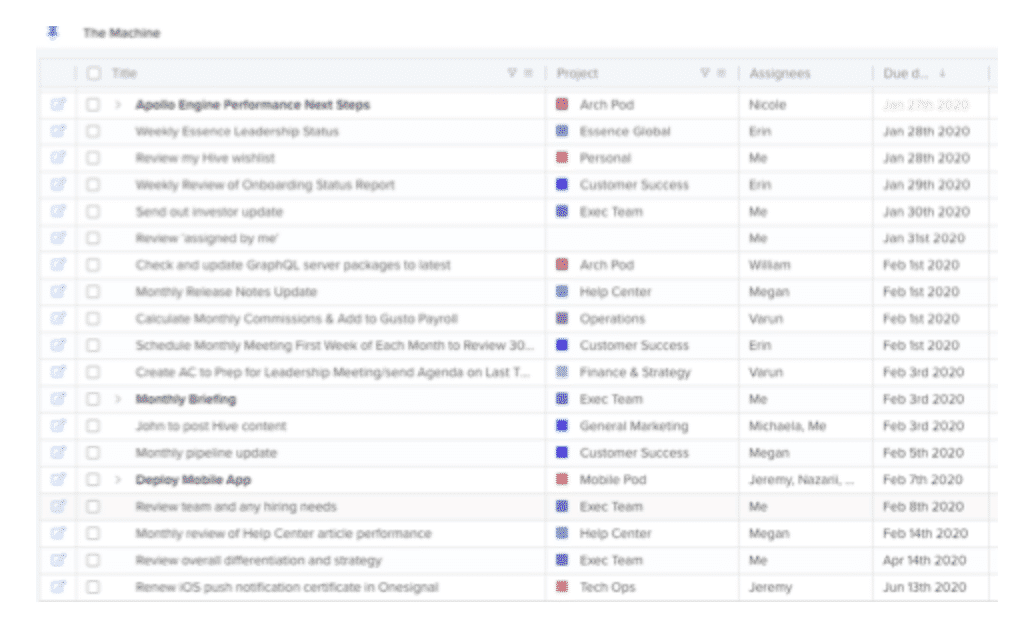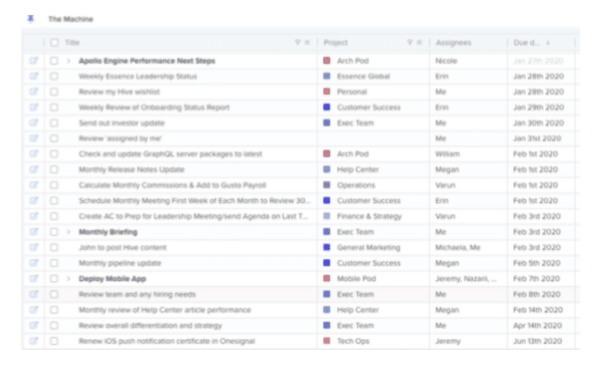Every company has unique ways of working that help enable efficiency, communication and collaboration across the organization. At Hive, we’ve quickly grown from an organization of 15 people to a company of over 40 in the last 18 months, and have had to adapt our unique ways of working to better acclimate to our growing team. One of the biggest ways we did this is through something we’ve branded the Action Matrix. This matrix is a living, breathing document that tracks everything our organization does.
To back up a bit, the matrix is a tool to track three types of actions: recurring, triggers, and projects. A recurring action is one that comes up at a specific frequency (yearly, monthly, etc), and some examples of that are yearly holiday party planning or biannual performance reviews. Triggers are exactly what they sound like — something happens that triggers an action to take place. An example of this is when an employee starts at a company, a set of on-boarding actions are triggered to help bring them up to speed on the organization. Finally, projects are larger lift items that usually involve cross-department collaboration. An example of this is the introduction of a new project management or HR software.
Once you’ve taken a look at the different types of actions that occur in your organization, you can determine four things: what the action or job actually is, the trigger, the duration, and who is doing it. From there, you can build out an Action Matrix of everything that gets done on a team or organization. Here’s what it will look like when you start:

This outline of duties and responsibilities is imperative for an organization, especially in this new remote work era. We’re confident that there are three things that will happen when you implement the matrix: you’ll stop doing shadow work, you’ll stop bringing sand to the beach, and you’ll easily be able to find the white space. The idea that you’ll stop doing shadow work means that you will stop duplicative work. You’ll also stop doing work that is like “bringing sand to the beach,” which is when someone does work that has already been done or doesn’t need to be done. Finally, you’ll be able to find the white space, i.e. what are people not doing that we really need to tackle? From there, you can create new “Jobs” in the matrix and figure out how long you think people should be spending on them, how long they should be happening, and who will tackle it.
You might be thinking: is this something you ACTUALLY use at Hive? The answer is yes, and we use Hive to track it all. Each action is individually built out in an action card, assigned to a person, placed in a project with a due date, and assigned a frequency. You can see a rough outline of how these items look together in the image below. We’ve found that Hive’s table view is the best for viewing the matrix, as it gives you an Excel-like look at actions in a true matrix form. That being said, you can utilize Hive’s flexible project views to look at all actions in Gantt, Kanban, calendar, or portfolio view. Once your actions are compiled and assigned, you’ve got a crystal clear view of everything happening in your organization at any given moment.

What does the matrix do for us? First, it helps us to better understand everyone’s free vs recurring time. The matrix helps show us how much work people are doing on a daily, weekly, and monthly basis. With this knowledge, we can better delegate and understand bandwidth. Second, it helps us figure out which roles we need to hire for and how to break them down. Once we’ve identified white space in the matrix, we can sift through all of those tasks we need to get done and craft a role around them. Finally, it helps everyone in our organization avoid burnout. Because we’ve outlined exactly what everyone is doing, we are able to make tweaks and changes to avoid overloading one individual with work. That’s also where the idea of defining new roles comes into play.
This matrix has saved us countless hours, and as we continue to perfect our utilization, especially during this period of remote work, we’re confident that more benefits will emerge the longer we use it. Want more information? Comment below or email hi@hive.com with any questions.




